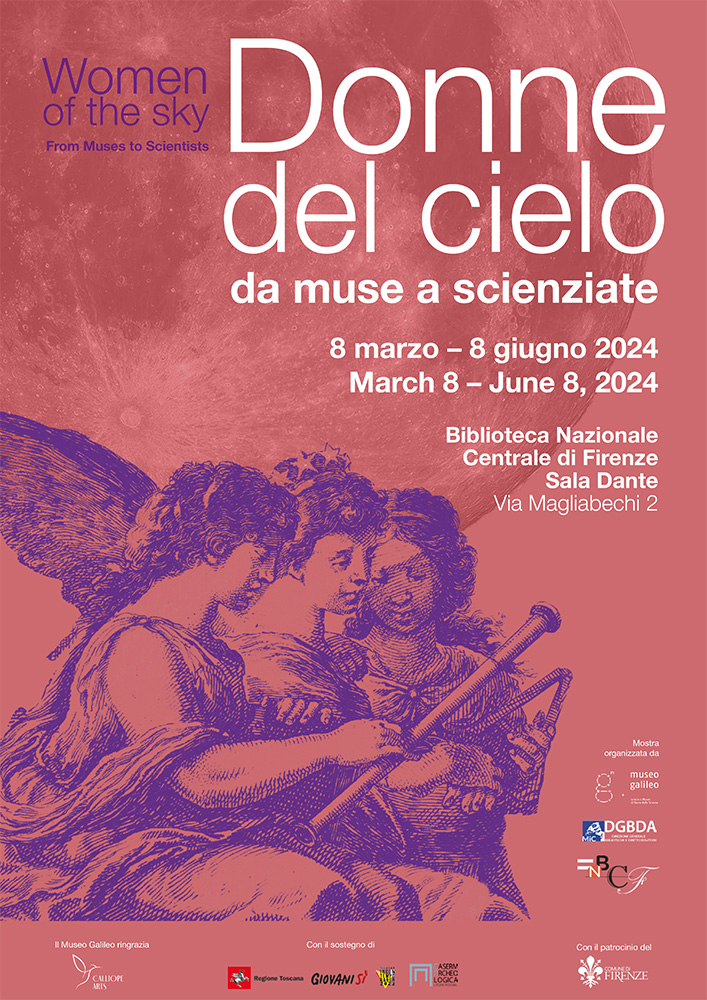Off-site
Biblioteca Nazionale Centrale di Firenze, Sala Dante
Florence, Via Magliabechi 2
Women of the Sky:
From Muses to Scientists
Organised by the Museo Galileo Museum and the Biblioteca Nazionale Centrale di Firenze
Under the patronage of the Municipality of Florence
With the support of Regione Toscana, GiovaniSì, InContemporanea, Caserma Archeologica
The Museo Galileo extends its thanks to Calliope Arts
This exhibition, the first of its kind in Italy, focuses on the role of women in astronomical research and on exploring the female images that most frequently feature in representations of the cosmos from the Renaissance to the early twentieth century.


Drawing on the rich holdings of the Central National Library of Florence, this exhibition presents scientific, literary and cartographic works that reveal the presence of female protagonists and/or authors, in texts and manuscripts characterised by the association between women and the celestial spheres. Part of the exhibition is devoted to astronomical themes presented in the ‘querelle des femmes’, i.e. in works arguing for intellectual and social equality between men and women. The National Library’s texts are presented in dialogue with scientific instruments from the Museo Galileo and private collections, and in conversation with astronomy-inspired artwork. In fact, The Variables of the Swan are an integral part of the exhibition. This series of seven monumental canvases by artist Ilaria Margutti are a nod to studies conducted by Henrietta Swan Leavitt. Margutti has interpreted Leavitt’s complex mathematical calculations on canvas, using the ancient technique of embroidery, to reproduce the Magellanic Clouds’ coordinates, comprised of 1,777 variables recorded by Henrietta Leavitt between 1904 and 1908. Eight original videos – accessible via QR code – illustrate the topics covered in the exhibition’s various sections. A comprehensive programme of side events (including guided tours, lectures and concerts) accompanies Women of the Sky: From Muses to Scientists. The programme also foresees the creation of a new digital library dedicated to exhibition themes, featuring all the texts on display.
sections
The exhibition is divided into seven sections:
Women of Stars. Constellations and Planetary Divinities
Recondite Harmonies. Muses, Sirens, and World Machines
Dignity and Prejudice. Astronomy for Everyone
New Views onto New Worlds. Telescopes, Satellites, and Galilean Echoes
Travellers of the Cosmos. Between Dream and Science
Women of Science. From Astronomy for Ladies to Women Astronomers
When the Body Is Celestial. Astral Images of the Feminine Identity
Info
Biblioteca Nazionale Centrale di Firenze, Sala Dante, Via Magliabechi 2, Florence
Hours:
Monday through Friday 10 am - 5 pm (last entrance 4:30 pm)
Saturday: 10 am - 1 pm (last entrance 12:30 pm)
Sunday and holidays closed
Admission free
For information:
055 2491997,
Highlights
Della dignità, et nobiltà delle donne. Dialogo
Cristoforo Bronzini
Firenze 1625
A declaration of the dignity of women dedicated to Grand Duchess Maria Maddalena. The author presents himself as a “defender of women,” praising their abilities in the arts, philosophy, logic, astrology, and geometry.
Digital library Women of the Sky
This is a thematic digital library that, in addition to including the works on display in the exhibition, offers structured paths for accessing the contents and presents itself as a research environment open to continuous updating and implementation. The project experiments with a new form of valorization of library collections by relating the exhibition set up in the National Central Library of Florence with the digital corpus published by the Museo Galileo.
Variables of the Swan. Seven canvases for the sky of Henrietta Leavitt
Ilaria Margutti
2021-2024
Drawing on Leavitt’s studies on the Cepheid Variables, Ilaria Margutti has embroidered on fabric seven big canvases that reproduce some glass plates examined by Leavitt and the coordinates recorded between 1904 and 1908.
Necessity and Parcae
in Disegni per gli Intermedi della Commedia “La pellegrina”
Bernardo Buontalenti
1588-1589
Firenze, Biblioteca Nazionale Centrale
Watercolor sketch of the spindle of Necessity encircled by the three Parcae: Lachesis (or Past), Clotho (or Present), and Atropos (or Future). Inspired by Plato’s Republic, the spindle represents the axis around which the planets spin, and is therefore a model for the harmonic order of the cosmos.
Astra medicea
Jean Chalette
1611
Carpentras, Bibliothèque Inguimbertine
This work should have been dedicated to Maria de’ Medici, queen of France, who sits here enthroned on the globe of Jupiter surrounded by the satellites Cosimo I, Cosimo II, Francesco, and Ferdinando.
Astronomia
Johann Meyer
Zurigo 1707
Astronomers Ptolemy, Copernicus, and Tycho Brahe present their world systems to Urania. At the sides are represented the new celestial discoveries revealed by the telescope: sunspots, the phases of Venus and Mercury, lunar craters, deformities on the surface of Mars, the satellites of Jupiter, and the ring of Saturn.
Pocket refracting telescope
Dollond
Londra, c. 1760
This is a small brass and glass telescope coming from the deposits of the Museo Galileo.
Machinæ coelestis
Johannes Hevelius
Gdańsk 1673
This is the earliest representation in an astronomical treatise of a woman conducting observations with a scientific instrument. The figure is Hevelius’ wife, Elizabeth, who would later edit the posthumous edition of her husband’s Uranographia (1690).
Plenilunio
Maria Clara Eimmart
end of the 17th century
Bologna, Università di Bologna - SMA - Museo della Specola
Trained in the astronomical observatory built by her father, Maria Clara Eimmart combined astronomical expertise with great artistic skill, representing comets, the phases of the Moon and Venus, Jupiter with its satellites, and Saturn.

 EN
EN  IT
IT 









